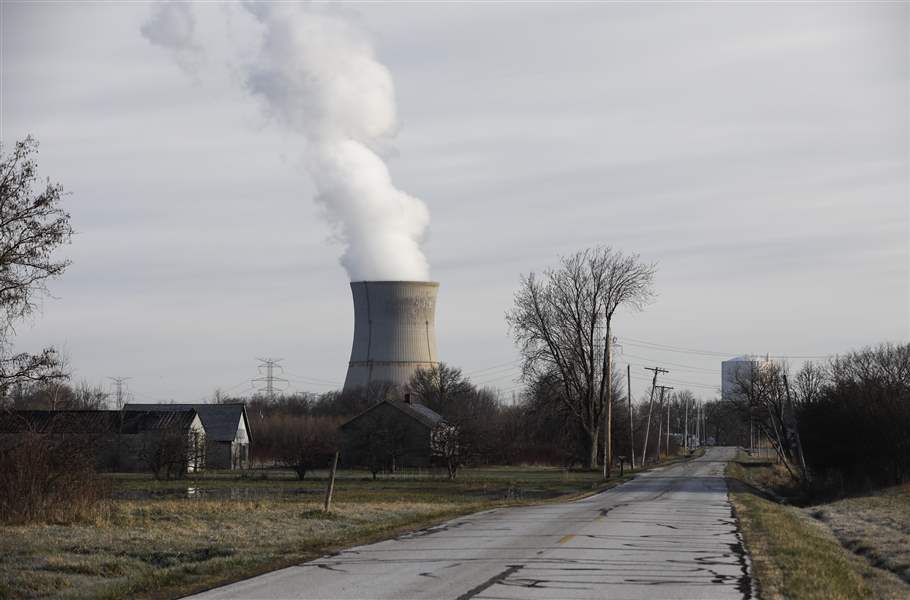
Full shutdown at Davis-Besse to take decades
6/26/2018
FirstEnergy Corp.'s Davis-Besse Nuclear Power Station in Oak Harbor, Saturday, April 22, 2018.
The Blade/
Buy This Image

FirstEnergy Corp.'s Davis-Besse Nuclear Power Station in Oak Harbor.
PORT CLINTON — During a meeting called to discuss Davis-Besse’s 2017 operating performance, the U.S. Nuclear Regulatory Commission went over the long process of how the Ottawa County nuclear plant will be dismantled starting less than two years from now unless a bailout or buyer emerges.
The process, called decommissioning, can take up to six decades, according to NRC rules discussed during the meeting on Tuesday night at the Camp Perry Conference Center west of Port Clinton.
It was the agency’s first meeting with area residents since FirstEnergy Solutions and FirstEnergy Nuclear Operating Co. filed for bankruptcy protection in March. Both are subsidiaries of FirstEnergy Corp., which has said it is getting out of electrical generation and focusing on transmission.
A crowd of about 30 people attended, many of them current or former plant employees.
Although he was not one of the presenters, FirstEnergy Solutions spokesman Thomas S. Mulligan told The Blade afterward that the utility subsidiary has chosen the SafStor method of decommissioning for Davis-Besse, one of three the NRC allows. The FES plan is to transfer radioactive fuel into water containing boron for four years, then seal it in concrete boxes for as long as 56 years.
The length of time depends on how fast the radioactive material decays.
“At this point, we’re not going to try to predict how long it will take,” Mr. Mulligan said.
The NRC’s other two types of decommissioning strategies, explained at bit.ly/2jG1eiF, are Decon — described as immediate dismantling of all equipment and structures — and Entomb, which is immediate encasement in concrete. SafStor is often considered “deferred dismantling,” because it allows for a more gradual removal of parts as fuel decays.
The 700-member work force, though, may not notice much difference in terms of its ability to remain employed.
While the NRC requires security as long as a site has radioactive fuel, other positions are expected to be terminated sooner.
“Once the fuel has been stored, the only remaining employment will be security and some fuel-handling,” Mr. Mulligan said.
FES has announced it will close Davis-Besse by May 31, 2020, unless a bailout or buyer emerges.
It also owns three other nuclear plants, and has announced it will close the last of them by the end of 2021 unless a bailout or buyer emerges. Those are the Perry nuclear plant east of Cleveland and the twin-reactor Beaver Valley complex west of Pittsburgh.
All four of them — as well as many of the nation’s 99 nuclear plants — can no longer compete against rock-bottom natural gas prices and competition from renewable energy sources.
During an afternoon news conference and during the meeting, NRC officials said Davis-Besse has continued to perform safely with no major operational issues beyond a “white” finding of low to moderate safety significance in the fourth quarter of 2017, which involved a failure over how instructions were given to maintain a safety-related pump. The NRC uses a color-coded system for violations, with white being the least significant.
Shawn Harwell, an NRC financial analyst, answered several questions about the FirstEnergy Solution decommissioning trust fund, which was found to contain $550 million through Dec. 31, 2016, when the NRC last audited utility numbers in March, 2017.
That, according to the agency, appears to be enough to do the decommissioning, assuming there will be at least a 2 percent return on investments as the work is being done, Mr. Harwell said.
The NRC will produce its next audit in March, then annual reports after that on the financial health of that fund because of the closure announcements.
Although the agency has been notified about the potential closures, FES is not legally required to shut down its plants until it files what’s known as a Post Shutdown Decommissioning Activities Report. Utilities have two years to file those reports from the date of closure announcements, Prema Chandrathil, NRC spokesman, said.
President Trump recently gave U.S. Energy Secretary Rick Perry a directive to come up with a government plan for staving off more closures of nuclear and coal-fired power plants. Critics have called that an act of socialism because of how it would interfere with electricity markets, and vow a concerted legal fight.
The NRC holds public meetings annually near each of the nation’s 99 nuclear plants to discuss their prior year’s performance.
Davis-Besse is about 30 miles east of Toledo, along the Lake Erie shoreline. It is Ottawa County’s largest employer, and has been online since 1977.
Contact Tom Henry at thenry@theblade.com, 419-724-6079, or via Twitter @ecowriterohio.